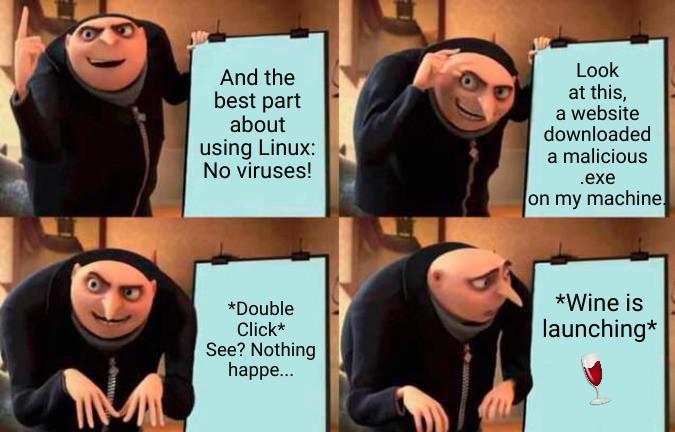I just got a real bad malware on my windows PC and I'm legit considering using Linux as a response. What's the best into to someone who isn't a programmer but understands computers relatively well enough?
linuxmemes
Hint: :q!
Sister communities:
Community rules (click to expand)
1. Follow the site-wide rules
- Instance-wide TOS: https://legal.lemmy.world/tos/
- Lemmy code of conduct: https://join-lemmy.org/docs/code_of_conduct.html
2. Be civil
3. Post Linux-related content
sudo in Windows.4. No recent reposts
5. 🇬🇧 Language/язык/Sprache
6. (NEW!) Regarding public figures
We all have our opinions, and certain public figures can be divisive. Keep in mind that this is a community for memes and light-hearted fun, not for airing grievances or leveling accusations.Please report posts and comments that break these rules!
Important: never execute code or follow advice that you don't understand or can't verify, especially here. The word of the day is credibility. This is a meme community -- even the most helpful comments might just be shitposts that can damage your system. Be aware, be smart, don't remove France.
Try a few different distros. People often recommend Mint for a beginner. I use Fedora personally, I also like Debian, it's stable but a bit boring and can be outdated. You can also creat a bootable live USB and try before you install!
To clarify, because I think this would be pretty confusing for someone who isn't already into Linux.
So a "distro" is short for a distribution of linux. Strictly speaking, Linux is just a kernel which is a technical component of an operating system. A few different organizations have taken the Linux kernel and added the necessary additions to turn it into a typical PC operating system e.g. Ubuntu, Linux Mint, Fedora, CentOS, Arch Linux, Manjaro Linux. Some are harder to get set up and some are plug and play. Ubuntu, Linux Mint, and Manjaro are considered to be "easy" to set up. Arch Linux is typically considered the hardest.
But how do you actually install it? (1) choose the distro. (2) download the .iso file from their website (a few gigabytes). (3) burn it into a spare usb flash drive to make a "live boot usb". (4) go into your BIOS and select to boot from your usb instead of your typical hard drive. Now you should be in your chosen distro. Conside this a sandbox that is contained to only your flashdrive. If you shutdown and remove the flash drive, nothing would change. (5 optional) play around and try it out. Do you like it? (6) Double click the installer on the desktop to install it on your hard drive for-real.
A note on step (3), you can find guides for this online. My favorite software that does this on windows is rufus.
A note on step (4), everyone's BIOS looks a little different. You can search "how to change boot options on XYZ" for your laptop/motherboard.
A note on step (6), if you really hate windows, you're free to nuke it, but your installer will give you the option to "install alongside windows" which will let you choose which OS to boot into on startup. This is known as "dual booting". It's the option with less commitment, but sometimes minor issues come up that requires troubleshooting (windows likes to fuck shit up when it updates).
I haven't run a Linux machine in years. Has wine improved or was I just not savvy enough to get things to run on it?
It's gotten significantly better since ~2010 or so when I was first struggling with it. Valve developing Proton on top of it definitely didn't hurt even if that in particular is more games focused.
I didn't know malware compatible was a term, oh it's wonderful! I'm gonna use it on people in real life hehe
